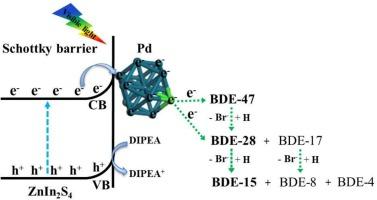2,2 ',4,4 ' -四溴联苯醚在纳米钯修饰硫酸锌光催化剂上的高效还原脱溴
IF 4.7
3区 化学
Q2 CHEMISTRY, PHYSICAL
Journal of Photochemistry and Photobiology A-chemistry
Pub Date : 2025-08-21
DOI:10.1016/j.jphotochem.2025.116711
引用次数: 0
摘要
多溴联苯醚(PBDEs)是一类重要的持久性有机污染物,由于其对环境的影响而受到越来越多的关注。研究了纳米钯修饰ZnIn2S4微球对2,2 ',4,4 ' -四溴联苯醚(BDE-47)的高效降解。以甲醇为溶剂,N,N-二异丙基乙胺为空穴牺牲剂,在可见光(λ > 420 nm)照射下,BDE-47的最佳钯负载为0.1%,降解效率为99%,在3 h内的最快反应速率为2.252 h−1。纳米pd修饰显著增强了光生载流子在ZnIn2S4中的迁移,从而提高了BDE-47的去除效率。BDE-47的降解途径涉及分步脱溴,光生电子是启动还原性脱溴过程的主要活性物质。BDE-47还原主要生成2,4,4 ' -三溴联苯醚(BDE-28)。密度泛函理论计算表明,在BDE-47中,纳米Pd与CBr键相互作用,尤其是邻c - br键,其对纳米Pd的亲和力比旁位的CBr键更强。这是促进有效和优先去除邻位溴原子的关键因素。该研究强调了Pd/ZnIn2S4复合材料在光催化去除卤化环境污染物方面的巨大潜力。本文章由计算机程序翻译,如有差异,请以英文原文为准。

Efficient reductive debromination of 2,2′,4,4′-tetrabromodiphenyl ether on nano-Pd-decorated ZnIn₂S₄ photocatalyst
Polybrominated diphenyl ethers (PBDEs) represent a significant category of persistent organic pollutants (POPs) that are garnering increasing attention due to their environmental impact. This investigation details the efficient degradation of 2,2′,4,4′-tetrabromodiphenyl ether (BDE-47) facilitated by nano-Pd-modified ZnIn2S4 microspheres. At an optimal palladium loading of 0.1 %, BDE-47 exhibited an outstanding degradation efficiency of 99 % and the fastest reaction rate of 2.252 h−1 within 3 h under visible light irradiation (λ > 420 nm) using methanol as the solvent and N,N-diisopropylethylamine as the hole-sacrificing agent. The nano-Pd modification significantly enhanced the migration of photogenerated carriers in ZnIn2S4, thereby improving the removal efficiency of BDE-47. The degradation pathway of BDE-47 involved stepwise debromination, with photo-generated electrons serving as the primary active species responsible for initiating the reductive debromination process. The BDE-47 reduction predominantly yielded 2,4,4′-tribromodiphenyl ether (BDE-28). Density functional theory calculation indicates that nano Pd interacts with the C![]() Br bond in BDE-47, particularly the ortho-C-Br bond, which exhibits a stronger affinity for nano Pd compared to the C
Br bond in BDE-47, particularly the ortho-C-Br bond, which exhibits a stronger affinity for nano Pd compared to the C![]() Br bond in the para-position. This is a key factor contributing to the efficient and priority removal of bromine atoms in the ortho-position. This study underscores the promising potential of Pd/ZnIn2S4 composites in the photocatalytic removal of halogenated environmental contaminants.
Br bond in the para-position. This is a key factor contributing to the efficient and priority removal of bromine atoms in the ortho-position. This study underscores the promising potential of Pd/ZnIn2S4 composites in the photocatalytic removal of halogenated environmental contaminants.
求助全文
通过发布文献求助,成功后即可免费获取论文全文。
去求助
来源期刊
CiteScore
7.90
自引率
7.00%
发文量
580
审稿时长
48 days
期刊介绍:
JPPA publishes the results of fundamental studies on all aspects of chemical phenomena induced by interactions between light and molecules/matter of all kinds.
All systems capable of being described at the molecular or integrated multimolecular level are appropriate for the journal. This includes all molecular chemical species as well as biomolecular, supramolecular, polymer and other macromolecular systems, as well as solid state photochemistry. In addition, the journal publishes studies of semiconductor and other photoactive organic and inorganic materials, photocatalysis (organic, inorganic, supramolecular and superconductor).
The scope includes condensed and gas phase photochemistry, as well as synchrotron radiation chemistry. A broad range of processes and techniques in photochemistry are covered such as light induced energy, electron and proton transfer; nonlinear photochemical behavior; mechanistic investigation of photochemical reactions and identification of the products of photochemical reactions; quantum yield determinations and measurements of rate constants for primary and secondary photochemical processes; steady-state and time-resolved emission, ultrafast spectroscopic methods, single molecule spectroscopy, time resolved X-ray diffraction, luminescence microscopy, and scattering spectroscopy applied to photochemistry. Papers in emerging and applied areas such as luminescent sensors, electroluminescence, solar energy conversion, atmospheric photochemistry, environmental remediation, and related photocatalytic chemistry are also welcome.

 求助内容:
求助内容: 应助结果提醒方式:
应助结果提醒方式:


